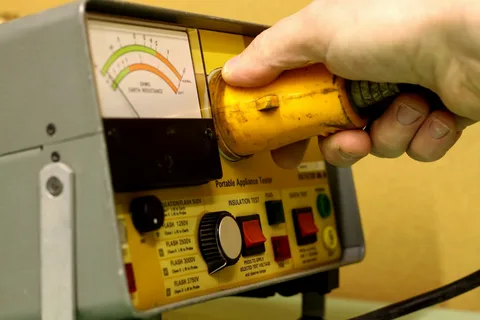Portable Appliance Testing (PAT) is a vital process in ensuring the safety of electrical appliances and equipment used in various settings, including homes, offices, factories, and commercial spaces. PAT testing involves a series of visual inspections and electrical tests to assess the safety of these appliances, thereby reducing the risk of electrical faults, fires, and electrical shocks. Here, we will delve into the essential aspects of PAT testing.
- Purpose of PAT Testing
The primary purpose of PAT testing is to ascertain the safety of electrical appliances. Over time, electrical equipment can deteriorate, develop faults, or become damaged, potentially posing hazards such as electrical fires or electric shocks. PAT testing helps identify these issues and ensures that appliances are safe for use.
- Frequency of PAT Testing
The frequency of PAT testing can vary depending on the type of appliance and the environment in which it is used. Generally, appliances are categorized into different classes, and the testing frequency is determined accordingly:
Class I Appliances (earthed appliances): These typically include large appliances with exposed metal parts, and they require more frequent testing, often every year.
Class II Appliances (double-insulated appliances): These appliances have two layers of insulation, and testing can be less frequent, often every 2-4 years.
Class III Appliances (low-risk appliances): These are usually supplied with a voltage not exceeding 50V and do not require routine PAT testing.
Extension Leads and Power Cords: These should be tested regularly, typically every year.
- Visual Inspection
The PAT testing process begins with a thorough visual inspection of the appliance. This includes checking for obvious signs of damage, exposed wires, frayed cables, and any loose or damaged parts. The visual inspection is critical for identifying external issues that could indicate internal faults.
- Electrical Tests
After the visual inspection, electrical tests are conducted using specialized PAT testing equipment. These tests may include:
Earth Continuity Test: This ensures that the earth connection is intact and can conduct electricity safely.
Insulation Resistance Test: This test checks the insulation of the appliance to ensure it is sufficient to prevent electrical leakage.
Polarity Test: This verifies the correct wiring of live and neutral conductors.
Leakage Test: This assesses the amount of electrical leakage from the appliance to detect potential faults.
- Record Keeping
It is essential to maintain detailed records of PAT testing. These records should include information about the appliance, its test results, the date of testing, and the name of the individual who conducted the testing. Having comprehensive records is essential for compliance and for tracking the condition of appliances over time.
- Remedial Action
If an appliance fails a PAT test or is found to have faults, it should be taken out of service immediately. Depending on the nature and severity of the faults, it can be repaired or replaced. Any necessary repairs should be carried out by a qualified electrician.
- Legal and Regulatory Compliance
Compliance with PAT testing is often required by law, industry regulations, and insurance companies. Failing to adhere to these requirements can lead to legal consequences and invalidated insurance claims in case of accidents.
In summary, PAT testing is a critical process that helps ensure the safety of electrical appliances and equipment. It involves visual inspections and electrical tests to identify faults, damage, or deterioration. By conducting PAT testing at appropriate intervals and maintaining accurate records, individuals and organizations can minimize electrical hazards and comply with legal and regulatory requirements. Contact us for more information on Metro-PAT 247 Limited.





